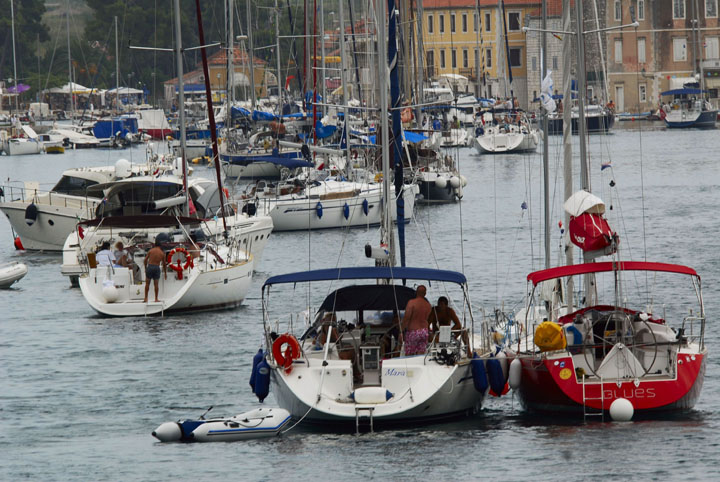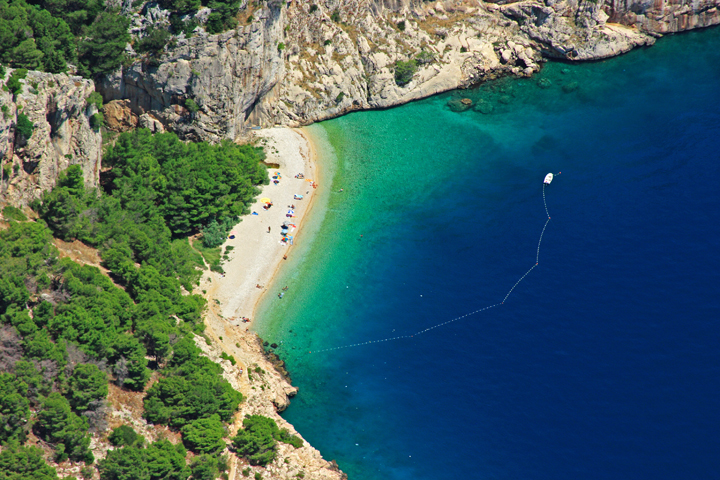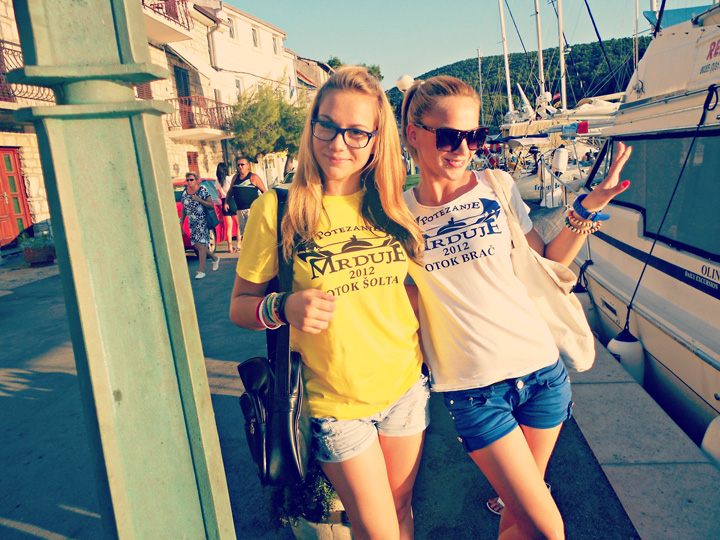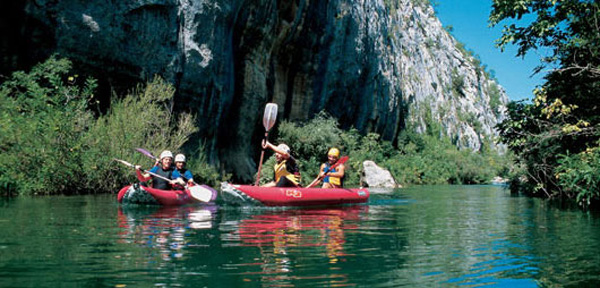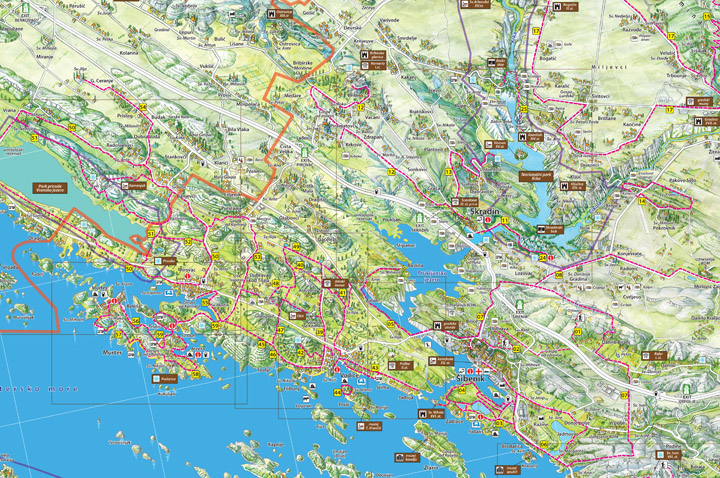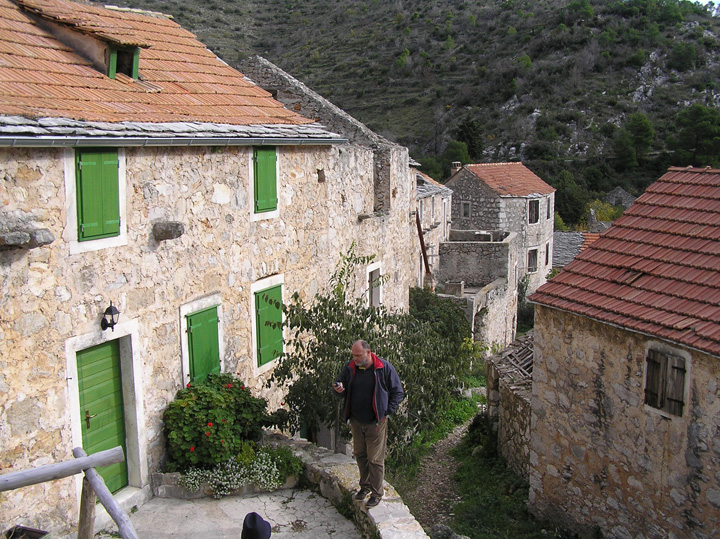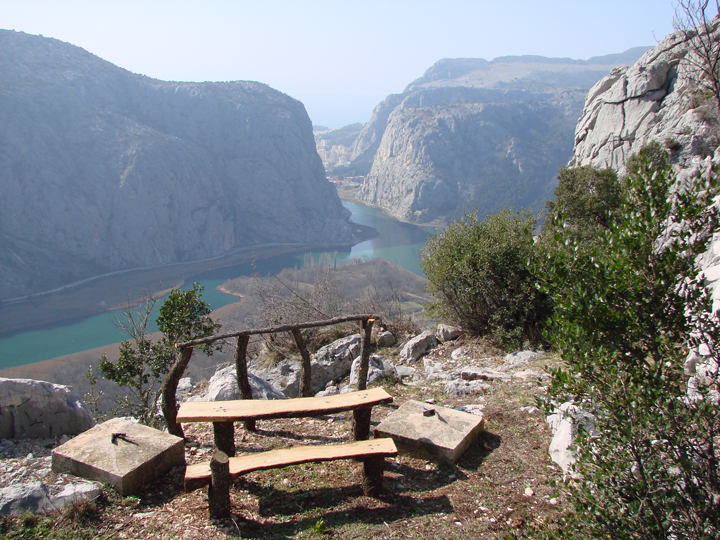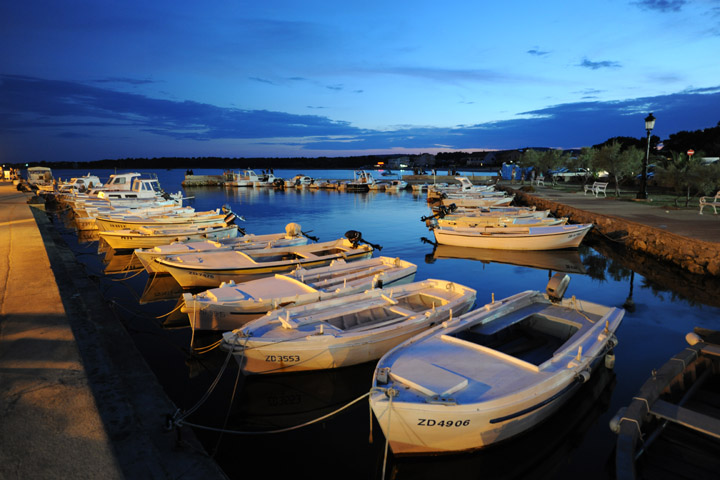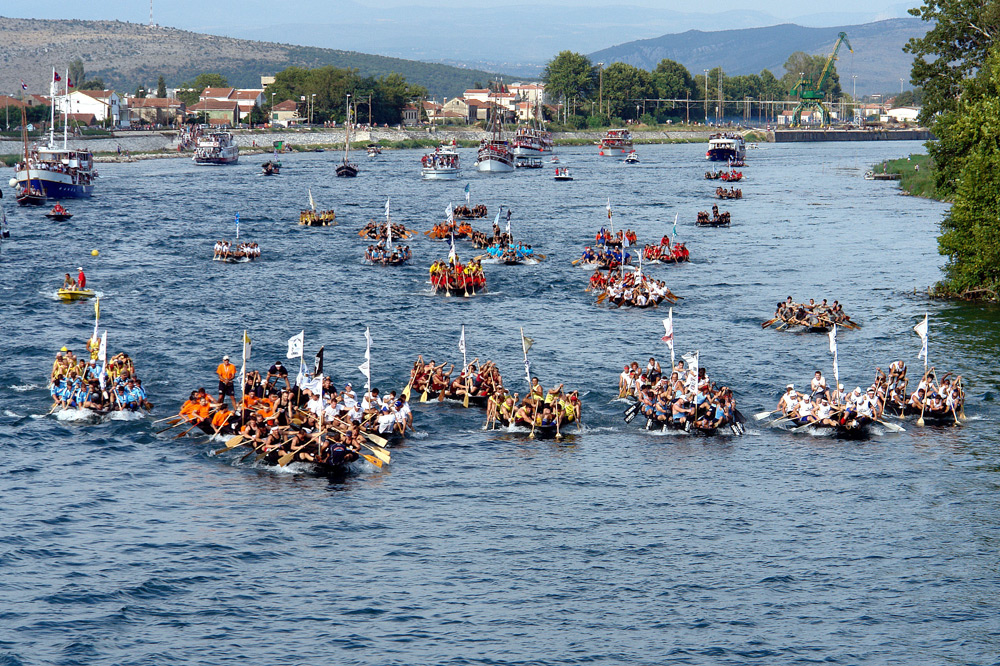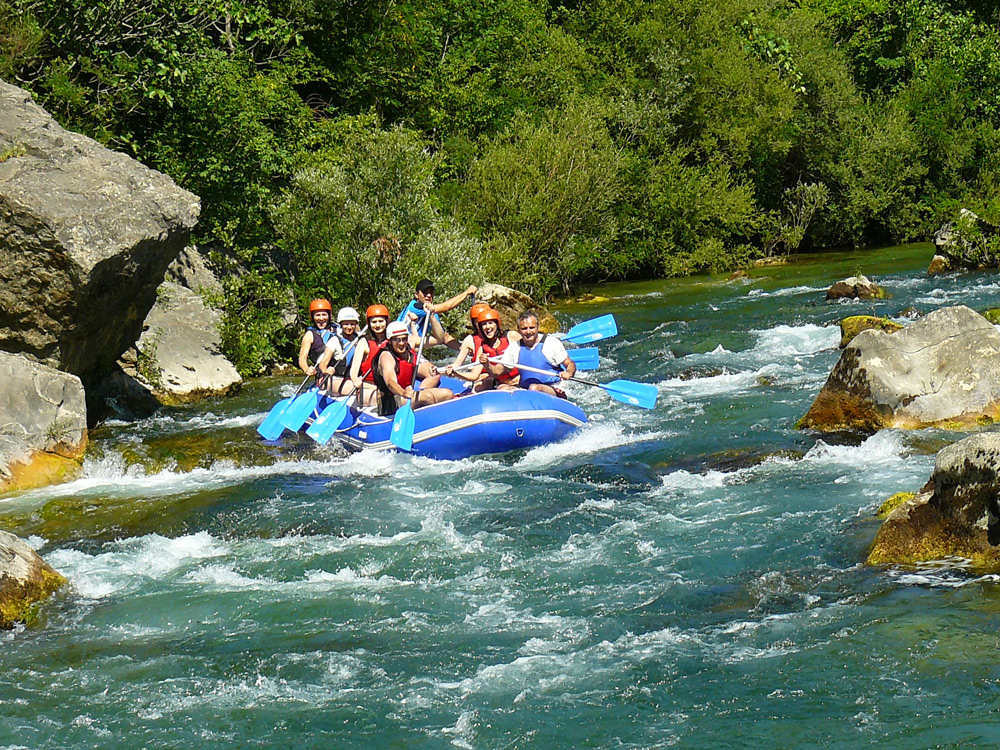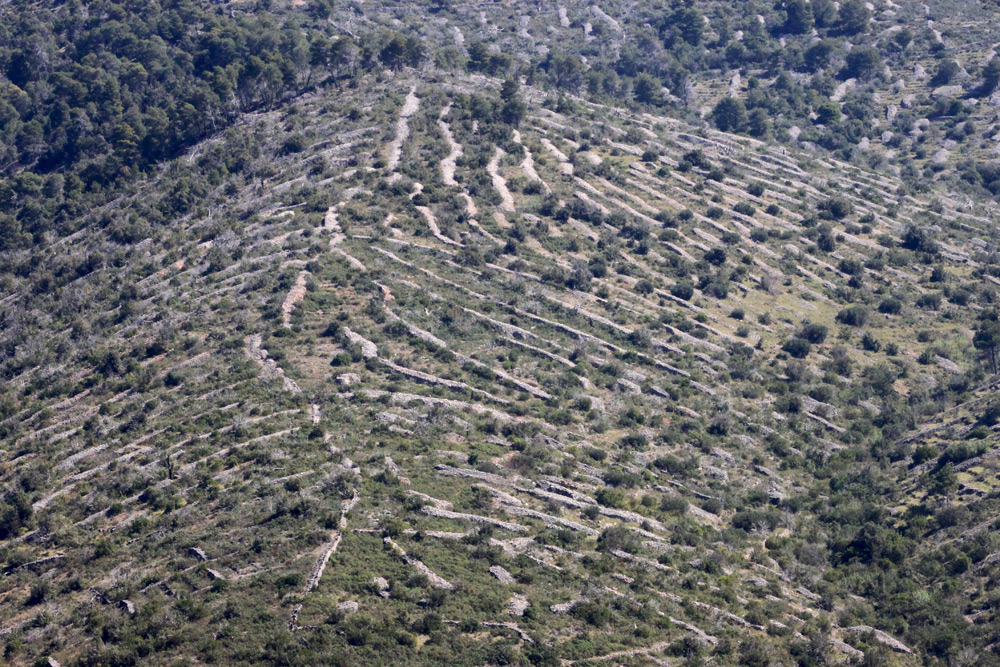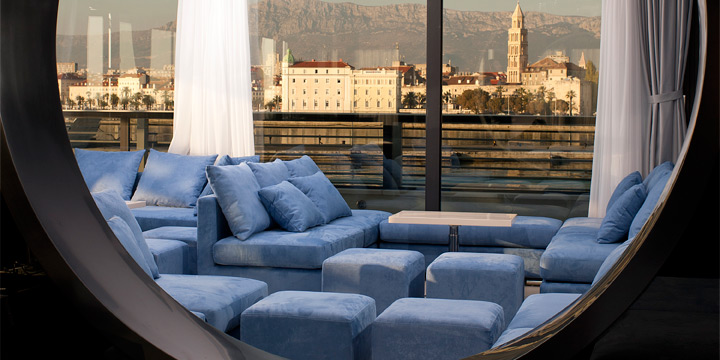An ideal sailing route in Dalmatia
SIX DAYS, SIX ISLANDS
AN ADRIATIC SAILING MUSICAL FEATURESA FLUTTERING JIB, CLANGING HALYARDS, AND SPLASHES ON THE BOW WITH AN INTERMISSION OF SIZZLING GRILLS, SINGING CRICKETS, CHIMING CHURCH BELLS AND SEA PLUNGES. STAR IN THIS ROMANTIC PLAY AS YOU EMBARK ON A SAILING HOLIDAY TO THE ENCHANTED ISLANDS OF CENTRAL AND SOUTHERN DALMATIA.
Text: Mila Hvilshøj
With over 1,000 islands dotting the Adriatic coast, it can be challenging to plan an ideal sailing route that will give you a true taste of Dalmatia. We embark on a six-day cruise that takes us to sixpristine islands with six distinct personalities without pushing the limit of time.
DAY 1: STARI GRAD, HVAR
Hop on board in Split and leave the magical Roman palace behind you as youventure to Stari Grad on the island of Hvar, an ancient settlement dating back to 384 BC. Don’t miss a visit to the Stari Grad Plain, a UNESCO-protected agricultural landscape where olives and grapes have been cultivated for over 2,400 years. Taste Hvar’s famous gregadafish stew at Pinetta paired with one of the sunny island’s famed wines before bobbing to sleep in the charming harbor.
DAY 2: PALMIŽANA, ST. KLEMENT
Raise your sails and travel to nearby Palmižana on St.KlementIsland, one of the gems of the Pakleni archipelago. The Meneghello family has nurtured this botanical sanctuary for over a century and they have ensured that a visit here will remain in your best memories forever. Find a hidden beach, take a stroll through Dagmar Meneghello’s art collection or dip your hands into afingerlickin’ pot of scampi on Toto’s palm-shaded terrace.
DAY 3: RAVNIK& VIS TOWN, VIS
After a night in paradise, cruise towardsthe mysterious island of Vis, making a little stopover by the islet of Ravnikfor a refreshing swim and visit to a green cave. Before sunset, approach Vis Town on Vis. Isolated for over 50 years when it was a military base, the island is rugged and virtually untouched. Explore Tito’s tunnels and caves, sip on the island’s white Vugava wines and nibble on a ViškaPogaćasardine focaccia at the Magić Tavern out of town.
DAY 4: ZAKLOPATICA BAY, LASTOVO
Be wakened by the light shining through the porthole and head to ‘lobster island’, Lastovo for a seafood feast in Konoba Triton in the Zaklopatica Bay. Take a 2km stroll to the island’s inland town, protected from pirates, and notice the famed chimneys, which were once status symbols of the old families there.
DAY 5: PROŽURA BAY, MLJET
Cross the sea to the northern shores of Mljet, Croatia’s greenest island and berth in Prožura Bay. Pop a bottle of rosé in the cockpit and take in the vistas of islets in the horizon and the grand Pelješac peninsula as a backdrop. Head toMljet National Park and visit a Benedictine Monastery on a lake island before returning to your tranquil bay for baked fish made in the most magnificent wood-fired ovens at Konoba Mare.
DAY 6: ŠIPAN& DUBROVNIK
Your last day of sailing includes a pit stop to the charming fisherman’s village of Luka Šipanska on Šipan, part of the Elephati archipelagofor a must-try lunch at the reputable KonobaKod Marko on the waterfront. After a hearty bite, release the mooring and sail to the mainland, disembarking in Dubrovnik, the pearl of the Adriatic.
The Dalmatian coast has countless bays and islands to be discovered by sailing holidaymakers but a six day ply to six different islands can still showcase the many personalities and beauties of Central and Southern Dalmatia. After six memorable days at sea, enjoy some time on the mainland with a promenade on the Dubrovnik city walls before venturing within them for a stroll down Stradun lined with 17-century houses, Onofrio’s fountains, bell-towers, and a Franscican monastery.
Central Dalmatia - beaches and activities
Central Dalmatia. The glistening Adriatic, the endless choice of quality and pristine beaches.
Take the Makarska Riviera, for example, whose 60km stretch of varied beaches from Brela to Gradac takes you through 18 towns and villages with something for everyone - from the family beach in a large town to a hidden gem in a remote fishing village. The only thing in common is the clear and enticing water, some of the cleanest sea in the world.
Or head to the islands - Brac, Solta, Vis and Hvar, from sandy to romantic, pebble to FKK, and for that extra privacy, seek out the emerald jewels such as the Pakleni Islands off Hvar, where the tourist tradition dates back to 1906. While the region is famed for its beaches and clean water, this only tells part of the story of a Dalmatian holiday on the coast, for there is also an exciting array of water attractions for the more active tourist - and not just in the sea.
In the heart of the Central Dalmatian coast lies the Cetina river, one of the region’s most diverse and least discovered attractions. Follow the trails of the pirates and Ottoman invaders along the 11 fortresses which guard the river, or get active in this fabulous water attraction for adventure tourism.
For pure adrenaline, find out why day trips from all over Central Dalmatia converge on Cetina for some of the best white-water rafting around, or for a more sedate introduction to the secrets of the Dalmatian hinterland by water, why not indulge in a little kayaking or a river canoe safari? Family packages are available, and it is a great way to escape the crowds while discover some of Central Dalmatia’s unique natural treasures. To reach Cetina, simply head for the town of Omis - as many pirates and invaders did in years gone by.
The call of the Adriatic is never far away on a holiday to Central Dalmatia, and there are plenty of water activities for visitors looking for a challenge. The region is become an increasingly important sailing destination, both for relaxation and competition, and each year brings new opportunities - from sailing schools for beginners to participation in the numerous regattas for the more experienced.
Wind surfing and kite boarding enthusiasts should head to Bol on Brac, which is becoming established as an activity destination, with those looking for treasures under the sea can
find them via diving schools in Markarska, Split, Hvar and Vis.
A trip to Central Dalmatia would not be complete without trying something authentic, and sporting enthusiasts should head to Bacvice beach in Split to take part in the curious game known as picigin, where grown men lunge desperately in an attempt to keep a small ball in the air. Time your trip well and take part in the 9th Picigin World Championships.
There is plenty of water-based excitement too for ornithologists keen to explore Central Dalmatia’s rich birding treasures with a river safari in the Pantan nature reserve, while fishing enthusiasts can choose from the sedate quayside fishing, to the challenges of the deep sea, or the ultimate extreme fishing challenge - spear fishing.
The glistening Adriatic and its neighbouring rivers and beaches - as diverse and challenging as you want it to be, and a reason why Central Dalmatia is the ultimate holiday destination
for all ages and interest groups.
For more information, visit the Central Dalmatia Tourist Board online. www.dalmatia.hr
[nivo effect="fade" directionNav="button" controlNav="true" width="620 px" height="360px"]
[image]http://hotspots.net.hr/wp-content/uploads/2013/10/Copy-of-HvarPakleniOtociZr9779o.jpg[/image]
[image]http://hotspots.net.hr/wp-content/uploads/2013/10/FOTO-Andrija-Carli-23.jpg[/image]
[image]http://hotspots.net.hr/wp-content/uploads/2013/10/Kanu-safari.jpg[/image]
[image] http://hotspots.net.hr/wp-content/uploads/2013/10/MurvicaPlazeBobanZr6690o.jpg[/image]
[image]http://hotspots.net.hr/wp-content/uploads/2013/10/PlazaMakarskaZr7180o.jpg[/image]
[/nivo]
Foto: Arhiva turističkih zajednica Splitsko- dalmatinske županije
Piše: Paul Bradbury
“
It is time to discover Brač
[nivo effect="fade" directionNav="button" controlNav="true" width="620 px" height="360 px"]
[image]http://hotspots.net.hr/wp-content/uploads/2013/10/Bol-franjevacki-samostan.jpg[/image]
[image]http://hotspots.net.hr/wp-content/uploads/2013/10/lozisca.jpg[/image]
[image]http://hotspots.net.hr/wp-content/uploads/2013/10/Mala-noćna-regata.jpg[/image]
[image]http://hotspots.net.hr/wp-content/uploads/2013/10/Potezanje-Mrduje.jpg[/image]
[image]http://hotspots.net.hr/wp-content/uploads/2013/10/Pustinja-Blaca.jpg[/image]
[image]http://hotspots.net.hr/wp-content/uploads/2013/10/SP2_5148.jpg[/image]
[/nivo]
There can be few islands in the world which can combine such an enviable offer of adrenaline sports, gastronomy, thousands of years of heritage, the finest beaches…
Treat yourself with the most memorable vacation and set off to discover numerous beauties, opportunities this island has to offer.
Its stone adorns major buildings around the world, such as White House in Washington, the Liverpool Cathedral, the Hungarian parliament in Budapest, but the island of Brač has plenty of other attractions to entice visitors to Central Dalmatia’s largest island. Conveniently located just an hour from Split (and with other connections from the mainland and Hvar), Brač has also managed to successfully brand itself as the island of culture and adventure.
Rich history of the island left numerous cultural monuments which depict ancient times with their complexion and ambience. Also, diverse and dynamic nature sculptured many rocks and treaded the paths on which you can free your adventurous spirit.
From gorgeous rocky and ancient ambience of the Blaca desert to the Zlatni rat where you can give yourself to the winds to carry you into the azure of the sea and the sky, you will definitely be breath taken, due to either adrenalin rush or the magnificent cultural heritage.
SUPETAR
Our journey will start at the main town of Supetar, whose regular car ferries provide the most accessible arrival point from Split to any of the island. Supetar has numerous events, cultural monuments and sports facilities, which make it an optimal choice for cultural tourism and active recreation. Admirers of sculpture should head for the gallery of Ivan Rendić, one of the island’s most famous sons. The gallery houses a collection of busts and drawing from the leading Croatian sculptor’s work, as well as interesting items such as a letter of thanks from British Prime Minister Gladstone. Top of the list of places to visit is Blaca desert, monumental hermit convent from 16thcentury, that will amaze you with its rocky complexions. These buildings look as if they emerge from the great rock behind them that dominates the landscape. Island of Brač’s Museum in Škrip, is festival the the island’s oldest and most authentic village. The museum showcases a cross section of the island’s history and cultural heritage, and rumour has it that Diocletian’s wife and daughter are buried in the Roman mausoleum. Be there on August 18 for the Škrip fair.
Read more about Supetar

SUTIVAN
Brač’s claim as an island of adventure includes the fabulous Vanka Regule, which this year takes place from July 14-21. Not quite an Olympics (but very close), the town of Sutivan hosts
this popular outdoor adventure sport and film festival, with competitors facing challenges in climbing, biking, sailing, slacklining, kayaking, hiking and stand-up paddling.
The historic core of Sutivan is a place of exceptional cultural value, and is protected by state laws as a cultural monument. However, not only lovers of history will come into their own in Sutivan
– for fans of active holidays, there is a Nature Park, an extraordinary resort and a place for rest and entertainment.
Read more about Sutivan
MILNA
With its deep and picturesque bay, Milna has been harbouring sailors since the times of emperor Diocletian, and the town’s ACI marina is an important stop on the Adriatic sailing route. Milna is a sailing paradise, and there are plenty of sailing-related activities to enjoy, of which the most intriguing is Potezanje Mrduje, where the residents of Brač and neighbouring Šolta perform the annual tug-of-war to determine the ownership of the tiny island of Mrduja, which lies between them. This year’s event is on 27 July with a concert of the Croatian music bend Macaklin and
famous singer Dražen Zečić.
BOL
The most iconic picture of the island is of course the unique beach of Zlatni Rat, the most eye- catching attraction of the southern town of Bol, which is connected by catamaran to Split and Jelsa on Hvar. Much more than a beach resort, Bol has become a top water sports destination, and offers some of the best windsurfing in Croatia. There is great diving, and it is one of the few places
in the country where one can indulge in kite boarding, and the Bol Tennis Open has attracted some big names in the past. Its cultural must sees include the stunning 15th Century Dominican monastery, while wine lovers have a wealth of choice when investigating the island’s wines, and a visit to vinoteka Jako vina is recommended. Bol has a lively summer cultural programme, including Bol Summer Night and great concerts at the monastery.
For those who care about culture and adventure, a must visit monument is Zmajeva spilja ( The Dragon’s cave), located near village of Murvica, about seven kilometers from Bol. It is called The
Dragon’s cave because of the relief of dragon in it. It was a temple and dwelling of the glagolitic priests. Reliefs in this cave are monument to the monastic life of the Glagolitic friars in the 15th century.
Read more about Bol
SELCA
Eastern port, a quiet fishing village of Sumartin, is connected by a new nautical bridge with regular ferry lines from Makarska and opens the doors to some of the island’s most
important cultural treasures. More than 10 monuments of historical figures adorn Selca, the only stone-carving place that is entirely built of white stone from Brač. Visit the first monument to Tolstoy in the world from 1911, or parish church which is because of its monumentality and beauty called the Brač Cathedral. Povlja were recently ranked as one of the 10 most beautiful places
in Croatia by Global Grashopper.
Read more about Selca
POSTIRA
Postira on the northern coast is also a place of history and tradition. Take the short road inland to the eco-ethno village of Dol, home to the unique gastronomic treasure called vitalac. Postira itself is home to the island’s first sardine factory, employing some 300 people and provide the highest quality to the restaurants of the island. Its heritage can be traced by the various archaeological remains, including a Roman villa rustica, a Benedictine convent and the early Christian basilica of St Lawrence. Film lovers should visit the 3rd Postira Seaside Film Festival on
August 1 -3.
Read more about Postira
An island of culture and adventure then, but also one of fabulous beaches and gastronomy, of nature and vistas. There can be few islands in the world which can combine such an enviable
offer of adrenaline sports, thousands of years of heritage, the finest beaches in one of the world’s cleanest seas, and all this just a one hour ferry ride from the Dalmatian capital of Split, which is served by 80 destinations this summer.
It is time to discover Brač!
River Cetina - a well of inspiration for adventurers
With its 102km of length, Cetina is considered to be one of the longest and most beautiful
of the Croatian rivers. Throughout history it has had a major role in the life of the local
population, as evidenced by the numerous archaeological sites from the time of the
Romans and Illyrians and medieval battles. Today the emerald river is a paradise
destination for lovers of nature and adrenaline-thanks to numerous opportunities to
engage in adventure sports, it has become a recognizable and popular destination for fans
of active tourism!
Canoeing, rock climbing and trekking are the most prominent of the adventure
sports on Cetina. The shrine of Leopold Mandić settles near the mouth of the river, as well
as a 2,6km long theme track bearing the same name. On top of all these features, Canoe
Safari rafting stands out as a particular attraction-an ideal adventure for all generations!
The 7km long canoe ride down Cetina canyon starts at Čikotina Lađa and finishes at Blato
na Cetini, or an alternate route: Blato na Cetini-Zadvarje and the thrilling experience
leaves no one indifferent! Besides the comfortable clothing you will be wearing for the ride,
all you need to bring is a dry set of clothes to change into after the trip is finished, as the
organizers provide all other equipment, as well as insurance in case of an injury (which is
very rare). If you are an adventure enthusiast, join this dynamic and attractive excursion!
Region of Šibenik - the best choice for hikers and cyclists
The mild climate gives you the opportunity to enjoy the landscape of our region at any time of year. Good news for all fans of cycling and hiking is the fact that the Šibenik area has more than 60 (approximately 400 km) of bike and walking paths, namely in the area of Šibenik, Zadar, Žirje, Vodice, Pirovac, Tribunj, National Park “Krka”, National Park “Kornati”, Skradin, Tisno, Grebaštica and Primošten.
Head out for a ride or a walk in the Dalmatian Zagora and discover the ancient fortress around the Krka River, stone houses and historical sites as Bribirska Glavica near town of Skradin, which keeps partly preserved walls from Illyrian times and the remains of Roman and early Croatian city; site of Burnum and preserved remains of a Roman camp near canyon of Krka, site of Danilo with the remains of prehistoric settlements, and the most prominent monument of Šibenik inland - Church of St. Salvation from the 9th century, known as the oldest Croatian church with preserved bell tower.
Discover the Dinara Mountain, where is situated the highest peak in Croatia at an altitude of 1831m, and enjoy gentle nature walks. Visit the historic towns of Knin and Drniš, their buildings and fortifications; a natural phenomenon - Krčić karst river which joins the river Krka, paths Vrana, Krka, or those in our islands. Take the educative hiking-ecological trail to visit Šibenik fortresses – it also offers a marvelous view of Šibenik and UNESCO cathedral of St. Jacob. Visit the gardens Jamnjak and Kamenar, as well as the Falconry centre in Dubrava, and when you want to take a rest, stop in one of our rural households and familiarize with the Dalmatian present way of life and the way it used to be, and enjoy delicious traditional specialties!
[nivo effect="fade" directionNav="button" controlNav="true" width="720px" height="360px"]
[image]http://hotspots.net.hr/wp-content/uploads/2013/01/mapa-biciklističke-staze.jpg[/image]
[image]http://hotspots.net.hr/wp-content/uploads/2013/01/Prizba.jpg[/image]
[image]http://hotspots.net.hr/wp-content/uploads/2013/01/BRIBIRSKA-GLAVICA.jpg[/image]
[/nivo]
SELECTION OF CYCLING AND WALKING PATHS IN ŠIBENIK KNIN REGION
NP „KRKA“
Entrance of Lozovac – Skradinski Buk
Educational hiking path Skradinski Buk
PIROVAC
Nature park „Vransko jezero“ – Pirovac – Prosika – Vrana Lake – village of Vrana
Pirovac – Škriline – Drašnice – Dejanovići
Pirovac – Kašić – Kaštelina – Vrućica
Pirovac – Čubrići – Morići – Putičanje – Bristovac
Pirovac – Ljubinac – Plišivica – Oštro – Burnjača
Pirovac – bay of Vrilo – St. Martin
PRIMOŠTEN
Big circle
Small circle
Bilo – Kruševo – Bilo
Dolac – Draga – Prhovo – Dolac
SKRADIN
Skradin (fort of Turina) – Prukljan – Sonković (fort of Sonković) – Piramatovci (Ždrapanj) – Bribir (archaeological site of Bribirska glavica)
Skradin – NP „Krka“ – Skradinski buk
ŠIBENIK
Educational hiking-ecological path „Ante Frua“
Fortress of St. John – fortresss of Šubićevac – Vidikovac – way between Jamnjak and Kamenar – ZOO Rakovo selo – Orlovača – Falconry center Dubrava – Dubrava
Ethno-eco-villages of the island of Hvar
„Ethno eco“ villages are optimal places to relax in peace and quiet, “disturbed” only by the sounds of nature, which means a lot to modern tourists because everyone is looking for something new and special. In other words, they want something different and natural - exactly what small Dalmatian villages are offering.[nivo effect="fade" directionNav="button" controlNav="true" width="720px" height="360px"]
[image]http://hotspots.net.hr/wp-content/uploads/2013/01/eko-etno-sela-otoka-hvara.jpg[/image]
[image]http://hotspots.net.hr/wp-content/uploads/2013/01/pogled-eko-etno-sela.jpg[/image]
[image]http://hotspots.net.hr/wp-content/uploads/2013/01/eko-etno-sela-1.jpg[/image]
[/nivo]
On the island of Hvar there are six ethno-eco villages. The town of Hvar has 4 ethno-eco-villages: Malo Grablje, Velo Grablje, Brusje and Zoraće.
Malo Grablje is primarily known for its marvelous microclimate and commitment of owners that it remains the property of indigenous people. In the village there is a wonderful tavern where in summertime one can enjoy local delicacies. Above Malo Grablje is Velo Grablje well-known for lavender and in our times for Lavender Festival which takes place in late June. The cultivation of lavender on the island apparently began thanks to one persistent manufacturer, Bartul Tomičić, who first began planting lavender and produced lavender oil in 1928 which is the beginning of systematic cultivation of lavender and lavender oil production on the island. After that the other villagers began to plant the lavender and in the following decades the place has become famous for its lavender and economically reborn.
Zoraće is one of the smallest ethno-eco villages, but with exceptional architecture and position, while Brusje as almost all other ethno-eco villages was long before the pastoral village, and later grew into a village of producers of wine, honey, olive oil and rosemary.
At the top of the island within the Municipality of Jelsa is located Gornji Humac, which boasts a wonderful view of the whole of Brač, Hvar, Korčula… all the way to Lastovo and Vis. Many houses in the village are from 15th century, and somewhat younger is the system for defense against the hail that the local farmers came up with to protect their vineyards – a cannon nest to dispel the storm clouds. Peculiar is a matrix of rural streets: they were constructed in such a way, which enables rainwater to flow in the tank sufficient to supply the entire village.
Near Stari Grad of Hvar lays ethno-eco village of Mala Rudina which boasts one the most beautiful historical squares.
All of the listed eco-ethno villages will yet be renewed with the funds of the EU amounted to 500 000 Euro, received by RERA Development Agency in cooperation with the Split-Dalmatia County.
So, when you come to Hvar, seize the opportunity to visit one of these villages. Feel and experience the genuine Dalmatia, and island of Hvar in even more remarkable manner!
Thematic trails in the city of Omiš
[nivo effect="fade" directionNav="button" controlNav="true" width="720px" height="360px"]
[image]http://hotspots.net.hr/wp-content/uploads/2013/01/tematske-staze-omiš.jpg[/image]
[image]http://hotspots.net.hr/wp-content/uploads/2013/01/Omiš-tematske-staze.jpg[/image]
[/nivo]
There are several thematic trails in the Omiš area, of which one of St. Leopold Mandić, opened in 2009, is the most prominent.
Blessed Leopold Bogdan Mandić, the second canonized Croatian saint, famous confessor and a promoter of Christian unity, originates from the small village of Poljica. He was the youngest of twelve children, and his parents, faithful Christians, came from Zakučac in Boka Kotorska, where Leopold was born on May 12, 1866. He entered the Capuchin Seminary at the age of 16 and was ordained to the presbyterate at the age of 24. After a short stay in Zadar, Kopar and Rijeka, by the will of his superiors he was finally determined to Padua, where this priest, a person small in height (only 135 centimeters tall) but with a great soul, met his death on July 30, 1942. He left his confessional in Padua only during the First World War, when he refused to accept Italian citizenship and had to go to the concentration camp as a stranger from an enemy country. He explained his decision in words: “Blood is thicker than water!”
Leopold Mandić was declared holy by Pope John Paul II, on October 16 1983, and his feast is celebrated on 12th May.
Thematic trail in honor of him is the first opened to the public in the Omiš area. It was created thanks to the work and cooperation of the Tourist Board of Omiš, Public institutions for managing protected natural values in Split-Dalmatia County and Split-Dalmatia County. Thematic (educational) route is situated in an area of significant landscape “Kanjon Cetine”. It is circular in shape and it has natural and cultural features of this part of the canyon highlighted on it. It is intended for the education of all visitors of Omiš and of protected “Kanjon Cetine” area and is part of the former “lifeline” of this region - of a path over the cliffs of Mosor, which connected the residents of Gornja Poljica to the other settlements.
Features of the thematic trail are:
Length: 2.6 km
Trip time: about 2.5 hours
Educational boards: 9
Resting places: 11
Lookouts: 5
Intensity: medium
Required equipment: comfortable sports shoes
Type of the tour: hiking
Besides the thematic trail of St. Leopold Mandić, 4 more will be made within one year: Illyrian river trail, the old Austro-Hungarian path, Laborers’ road and Ethno-Eco Village trail (Tugare). The goal is to use these thematic trails to promote cultural and rural tourism in the town of Omiš. Therefore, to present production and offer of traditional gastronomy products such as wine, olive oil and typical homemade delicacies like the Poljica soparnik which is protected as part of the national cultural heritage.
Cultural tourism would be presented through the late Roman villae rusticae, prehistoric heaps, the remains of the Illyrian culture, churches, shrines, late medieval tombstones, sarcophagi, etc. In the area which is covered by thematic trails there are 2 ethno-eco-villages, 50 registered family farms with accommodation facilities and a very diverse offer of indigenous gastronomic specialties.
Written by: Joško Stella
The Island of Vir - A new dimension in innovative tourism
Our readers might recall us recommending the beautiful sunny beaches of Vir as a top spot for spending and ideal vacation with your loved ones in our last issue. But it is also important to mention the constant effort of the island to introduce new and interesting additions to the classic tourist offers. The throughout the day animation on the beaches and the nineteenth century lighthouse as a top tourist facility, indicate the new dimensions in tourism in Vir.
The animation programs are organized in a way which allows you and your whole family to recreate and have fun whenever it suits your individual plans. Water aerobics, karaoke and various competitive games for both children and adults, mean you can relax and at the same time have fun no matter your age. On the other hand, if you happen to be a bit more of an adventurous type, there are numerous cycling routs, for instance Vir - Zadar. You could even go pro with your cycling ambitions as the island hosts no less than four bicycle competitions! Two of those take place at the beginning and closing of the season (weekends in June and September) along with the International cycling marathon in the pre-season period. There are even the Christmas and spring tours (end of March) which goes to say the island is working toward becoming and active vacation lovers resort all year round! To reinforce that agenda they have even arranged four free of charge transportation lines from Zadar as well as free animation programs.
Neretva
[nivo effect="fade" slices="3" directionNav="button" controlNav="true" width="720px" height="360px"]
[image caption="Maraton na Neretvi"]http://hotspots.net.hr/wp-content/uploads/2012/03/Maraton-na-neretvi-pod-Metkovicem.jpg[/image]
[image caption="Neretva"]http://hotspots.net.hr/wp-content/uploads/2012/03/neretva_1.jpg[/image]
[image caption="Panorama Metkovića"]http://hotspots.net.hr/wp-content/uploads/2012/03/metkovic-panorama-za-autobus.jpg[/image]
[image caption="Neretva"]http://hotspots.net.hr/wp-content/uploads/2012/03/neretva_2.jpg[/image]
[image caption="Ribarenje na Neretvi"]http://hotspots.net.hr/wp-content/uploads/2012/04/pct_180507v1.jpg[/image]
[image caption="Vid, rijeka Norin"]http://hotspots.net.hr/wp-content/uploads/2012/04/Vid-Norin.jpg[/image]
[image caption="Rijeka Norin po noći"]http://hotspots.net.hr/wp-content/uploads/2012/04/River-Norin-by-night1.jpg[/image]
[image caption="Panorama Predolac"]http://hotspots.net.hr/wp-content/uploads/2012/04/panorama-predolac.jpg[/image]
[image caption="Most"]http://hotspots.net.hr/wp-content/uploads/2012/04/MOST.jpg[/image]
[image caption="Neretva"]http://hotspots.net.hr/wp-content/uploads/2012/04/P5067709.jpg[/image]
[/nivo]
The last delta of Europe - richness at the Neretva estuary
In addition to the beautiful islands, mountains, karst and fertile hinterland, Dalmatia is proud of the latest Delta of Europe - Neretva river mouth.
The delta of the Neretva River, from Metković to the estuary on the north and northeast, is bordered by branches of the Dinaric Alps, and to the south by hills. To the west it is open to the sea and is under its constant influence. Precisely this brackish water is the right place for the growth of vegetation and fish fund. The wildlife is also diversified here - the last species of birds, which couldn’t be seen anywhere else in Europe, made their nests in this marsh area.
Climatic influences are very suitable for agriculture, for the famous Neretva tangerines and other citrus fruits, among which in the past years clementines have become increasingly popular, whereas at the beginning of the summer, it is all about peaches and nectarines. Precisely picking these cultures for years also represents a type of tourism that Neretvians have arranged for their guests. We must not forget hunting and fishing, which also brought many at the Neretva river delta… and after hunting and eels fishing, you can try preparing these delicacies, typical for this region.
In addition to these activities, even if you are not the athletic type, you will surely enjoy the photo safari through the backwaters of the river. A ride in the Neretva boat (you can paddle on your own, or choose a motor drive) through the vast backwaters, tributaries and lakes, finalized with occasional lunch at one of the many ranches (with an outdoor barbecue and homemade bread), will make one of the best memories. The Neretva River delta is a natural phenomenon, and a must-see!
Photo and text: TZ Metkovića
Adventure tourism on Cetina
[nivo effect="fade" directionNav="button" controlNav="true" width="720px" height="360px"]
[image caption="Cetina"]http://hotspots.net.hr/wp-content/uploads/2012/04/Cetina.jpg[/image]
[image caption="Cetina"]http://hotspots.net.hr/wp-content/uploads/2012/04/Cetina2.jpg[/image]
[image caption="Cetina"]http://hotspots.net.hr/wp-content/uploads/2012/04/Cetina3.jpg[/image]
[image caption="Cetina"]http://hotspots.net.hr/wp-content/uploads/2012/04/Cetina4.jpg[/image]
[/nivo]
Cetina River is with its 102 km one of the longest and most beautiful Dalmatian rivers. Furthermore, it is interesting from cultural and historical perspective because of its richness in archaeological sites - from the time of Roman legionnaires and Illyrians, all the way to medieval battles. These data are all indicative of the river’s importance for the life of local population.
Nowadays the river with its surroundings is increasingly linked to the development of active vacation or adventure tourism. From adventure sports, the most represented are rafting, canyoning, canoeing, free climbing and trekking, and apart from these, bicycling and horse riding. The Cetina River is known for being a fliming location: in the field from "tisne stine" (narrow cliffs) to Radman's mills, 10 movies about Winnetou (a character from the books of Karl May) were recorded. Near the mouth of the river there is a shrine of St. Leopold Mandić which is also the starting point of the eponymous thematic paths offering a breathtaking view of the stone gates of the river Cetina. At the estuary of Cetina stands the most famous pirate town in the Mediterranean – Omiš.
Treat yourself to a relaxing vacation on the most beautiful Dalmatian river. Breathe in fresh river air, free your mind from stress and activate your body. Adventure on the Cetina River is an unforgettable, inspiring and refreshing experience. Be prepared for the adventure of your life, come and enjoy rafting, canyoning, trekking and all other activities in a wonderful canyon of the Cetina River.
Author: Joško Stella
Secret Hvar
[nivo effect="fade" slices="3" directionNav="button" controlNav="true" width="720px" height="360px"]
[image caption="Hvar"]http://hotspots.net.hr/wp-content/uploads/2012/04/Hvar.jpg[/image]
[image caption="Hvar"]http://hotspots.net.hr/wp-content/uploads/2012/04/Hvar2.jpg[/image]
[image caption="Hvarska lavanda"]http://hotspots.net.hr/wp-content/uploads/2012/04/Hvar3.jpg[/image]
[/nivo]
City Hvar
As Town of Hvar was situated in the heart of the maritime and trading routes, many cultures, starting from early Neolithic through Hellenic and Roman culture to the Renaissance and Baroque, left their traces in the history of the island.
Over the centuries Hvar was major Venetian port in the eastern Adriatic. Nowadays it is a popular destination for international jet-setters and their luxurious yachts. On a hill above the town there is the fortress with the city walls that were built to protect the noble palaces from invaders and pirates. Today, Hvar's best restaurants and bars are situated in those palaces, Many hedonists from all over the world enjoy the rich island’s gastronomy and entertainment there.
Secret Hvar
Just ten minutes drive from the Town of Hvar, there is a totally different Hvar, covered with Mediterranean vegetation, vineyards, olive trees, lavender fields and endless stone walls, ready to be revealed to the occasional passers and adventurers seeking for new excitements.
The island has several old abandoned villages that are woken up as soon as tourists walk in.
Malo Grablje is a village hidden in the canyon with the ancient Municipal road, Via communis, which once linked the settlement of Hvar and Pharos. There is St.Tudor’s church, built in 19th century, which is open only twice in the year--the first Sunday in May and the first Sunday in October.
Two kilometers uphill from Malo Grablje lies Velo Grablje, founded in the 15th century. Archeological site Babina špilja is the evidence that the area around Velo Grablje was inhabited since the Neolithic period. After the vine disease, many residents of Velo Grablje and other villages immigrated to America and Australia, looking for a better life. Those who stayed in the village began the produce of rosemary and lavender essential oils. "Ružmarinska zadruga” was established in 1892 as the first such association in Croatia.
Stari Grad is considered to be the oldest town in Croatia. It was founded by the Greeks in 385 BC and was named Pharos. Behind the town there is the largest and the most fertile field on the Adriatic islands, famous by Greek land division. Since 2008 it is under UNESCO protection.
The road to the island’s highest peak St. Nikola is filled with rosemary, sage, lavender and other Mediterranean plants. At the foot of St. Nikola there is Sveta Nedija, a small village famous for the production of the best red wine – Plavac.
Vrboska is a small fisherman’s village, established in the 15th centuries by the fishermen from the nearby village Vrbanj. Because of its deep channel and several small bridges, Vrboska is also known as Little Venice.
After exploring the hidden villages of the island, the peaceful atmosphere can be enjoyed in an abandoned but well preserved village of Humac, founded in the 17th century. It is considered to be the ethnographic monument. Above the village there is the church of St. John and Paul, built in 1897. The church is open only once a year, June 26.
Restoran & lounge bar Imperium
[nivo effect="fade" directionNav="button" controlNav="true" width="720px" height="360px"]
[image caption="Restoran & lounge bar Imperium"]http://hotspots.net.hr/wp-content/uploads/2012/05/Imperium_4.jpg[/image]
[image caption="Restoran & lounge bar Imperium"]http://hotspots.net.hr/wp-content/uploads/2012/05/Imperium_6.jpg[/image]
[image caption="Restoran & lounge bar Imperium"]http://hotspots.net.hr/wp-content/uploads/2012/05/Imperium_5.jpg[/image]
[image caption="Restoran & lounge bar Imperium"]http://hotspots.net.hr/wp-content/uploads/2012/05/Imperium_3.jpg[/image]
[image caption="Restoran & lounge bar Imperium"]http://hotspots.net.hr/wp-content/uploads/2012/05/Imperium_2.jpg[/image]
[image caption="Restoran & lounge bar Imperium"]http://hotspots.net.hr/wp-content/uploads/2012/05/Imperium_1.jpg[/image]
[/nivo]
New Empire has floated inthe City Port of Split
Imperium as aexclusive restaurant, loungebar, night club and patisseries intend to rule with relaxed, comfortable atmosphere, by serving high class local food and drinks, with first class ambiance and most importantlya quality selectionof musicattracts abroad strataof society.
Translucentimpressiverestaurantits namejustifies with the sizeof two thousandsquaremeters, modern and elegant interior containing more restaurants levels, indoor and outdoor lounge bars witch are transforming in to a club when the night comes down. It's all in one, you are surrounded by walls of glass with a amazing sea view. The location isvery interesting, on the onehandyou seeSplit,on the otherislands, andaround youarrivinganddepartingshipsinthe harbor, so thebasicidea wasto get intothe housetofeel likea luxurycruise.
Designerspace iswell-known SplitarchitectDujeKaliternawho worked onthe arrangement ofall knownbarsin Croatia, adding that hisdesire was tokeepbuildinglong-modern look andnot tootrendy, but a modernrepresentativeoffer of Split.
Imperium is an ideal place for business meetings and pleasant socializing in the afternoon, as well as celebrations, promotions, parties and events in the evenings.
It is proud with its innovative and impeccably served Mediterranean cuisine, with an emphasis on seafood and approach to cooking andchefskillsNiksaBoban,a professorof contemporarycuisinein a privateschoolValner. Pastries, cakes,ice creamfrom our ownkitchenas well asfish,shellfish, fresh herbs, high quality oliveoil,seasonal vegetablesand foodsfrom the Dalmatian will dominate the Imperium menu.
Contact
Address: Gat Svetog Duje (ferry terminal), Split, Croatia
[styled_link link="http://www.imperium.hr" variation="slategrey" target="blank"]www.imperium.hr[/styled_link]
[styled_link link="http://www.facebook.com/imperium.split" variation="slategrey" target="blank"]www.facebook.com/imperium.split[/styled_link]
[email_link email="[email protected]" variation="slategrey"][email protected][/email_link]
Reservations: +385 21 338 555
WORKING TIME
Restaurant: 11-23h
Lounge Bar & Passeseries: 07-01h
Club: 21-04h

